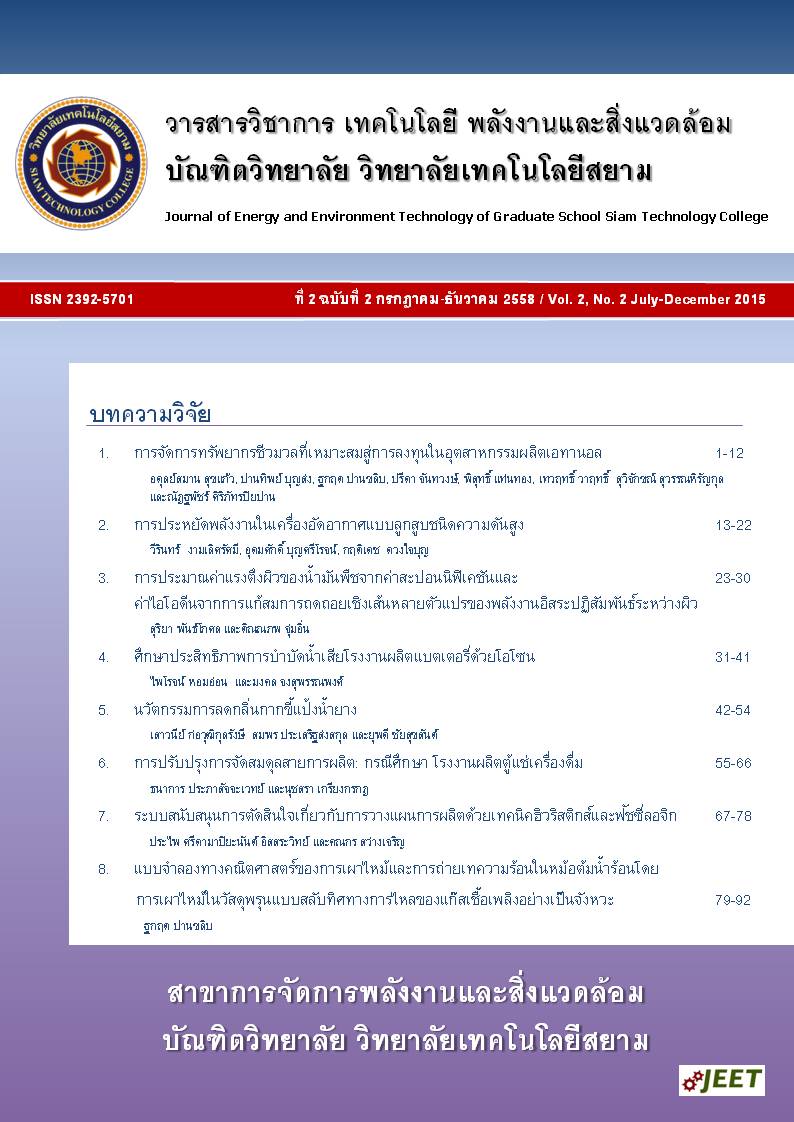Evaluation of the efficiency of ozone treatment on wastewater in the battery plant.
Main Article Content
Abstract
Wastewater discharge battery manufacturing plant, the process of water treatment and the contamination of ion solution lead (Pb2+) does not exceed the standards act. Although the contaminations of ion solution lead (Pb2+) will pass a standard by law. But there will also be the contamination of ion solution lead (Pb2+). Wastewater treatment by chemicals cannot to reduce the contamination of ion solution lead (Pb2+) up until the zero. The contamination of the main pollutants 2 as there is contamination of ion solution lead (Pb2+) and the contamination of sulfuric acid (H2SO4) with water. Therefore, the system wastewater treatment to use chemical with high alkalinity condition, such as sodium hydroxide (NaOH) to adjust the value pH of wastewater and cause precipitation with other processes. But because the water through the treatment process with chemical also value the contamination of ion solution's lead (Pb2+) is one of the values, that a chemical treatment system cannot reduce ion solution lead (Pb2 +) up until the zero. Ozone (O3) when dissolution is one oxygen atom, which is unstable according to equation O3 ---- > O2. + 2e . Oxygen ionization is sensitive to react violently with oxidizing solution ion heavy metals. Therefore, the ozone to experiment in optimization of wastewater treatment. So the contamination pollutant mixed with wastewater to zero, or to a minimum to help protect the environment. The experiment showed that the ozone has the ability to oxidize lead ions in solution (Pb2+) Change is PbO(s). So wastewater treatment by ozone can help to reduce contamination of ion solution lead. (Pb2 +) in released from the factory. The results from the experiment to test the relationship between. Increasing the amount of ozone concentration, and time constant 30 min. Quantity ion solution lead (Pb2+) reduced translation inversion with increasing the concentration of ozone. R2 = 0.840 and adding time ozone contact with wastewater concentration at ozone constant 300 mgO3 /hr quantity ion solution lead (Pb2+) reduced translation inversion follow increase to contact time. R2 = 0.872 which show that ozone can oxidize ion solution lead (Pb2+) is PbO (s) very good, seen from the value R2 of results from the experiment of a good level.
Article Details
เนื้อหาและข่อมูลในบทความที่ลงตีพิมพ์ในวารสารวิชาการ เทคโนโลยี พลังงาน และสิ่งแวดล้อม บัณฑิตวิทยาลัย วิทยาลัยเทคโนโลยีสยาม ถือเป็นข้อคิดเห็นและความรับผิดชอบของผู้เขียนบทความโดยตรง ซึ่งกองบรรณาธิการวารสารไม่จำเป็นต้องเห็นด้วย หรือว่าร่วมรับผิดชอบใด ๆ
บทความ ข้อมูล เนื้อหา รูปภาพ ฯลฯ ที่ได้รับการตีพิมพ์ในวารสารวิชาการ เทคโนโลยี พลังงาน และสิ่งแวดล้อม บัณฑิตวิทยาลัย วิทยาลัยเทคโนโลยีสยาม ถือเป็นลิขสิทธิ์ของวารสารวิชาการ เทคโนโลยี พลังงาน และสิ่งแวดล้อม บัณฑิตวิทยาลัย วิทยาลัยเทคโนโลยีสยาม หากบุคคล หรือหน่วยงานใดต้องการนำทั้งหมด หรือส่วนหนึ่งส่วนใดไปเผยแพร่ต่อ หรือเพื่อกระทำการใด ๆ จะต้องได้รับอนุญาต เป็นลายลักษณ์อักษรจากวารสารวิชาการ เทคโนโลยี พลังงาน และสิ่งแวดล้อม บัณฑิตวิทยาลัย วิทยาลัยเทคโนโลยีสยาม เท่านั้น
References
2. มงคล จงสุพรรณพงศ์ (พ.ศ.2550) การผลิตโอโซนในระบบพลาสมาความดันสูง สำหรับบำบัดน้ำเสียในบ่อเลี้ยงกุ้งและชุมชน
3. Mongkol Jongsuphaphong and Suntud Sirianuntapiboon (พ.ศ.2551) Design and application of new type of oxygen supplier for water and wastewater treatment.
4. Mongkol Jongsuphaphong1, Suntud Sirianuntapiboon1* and Bundit Limmeechokchai2 (พ.ศ.2553)
Evaluation of a pilot scale high pressure plasma ozonizer for use in wastewater treatment.
5. นางสาวเมธินี บุญชุบเลี้ยง (พ.ศ.2549) ผลของ Pb2+ และ Ni2+ ต่อประสิทธิภาพของระบบบำบัดน้ำเสียแบบเอสบีอาร์


